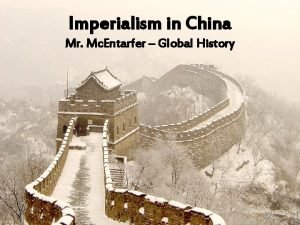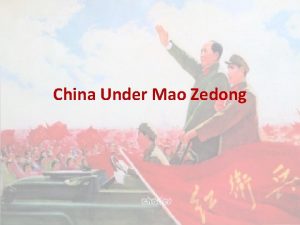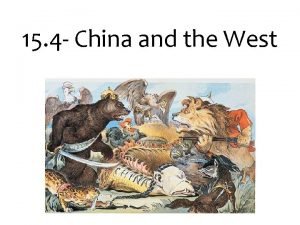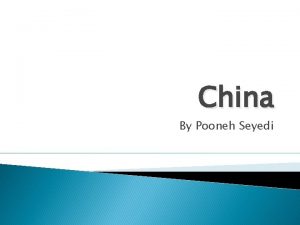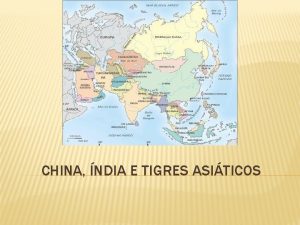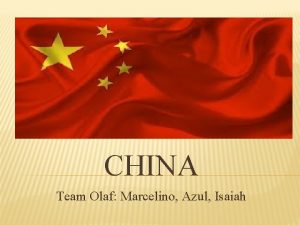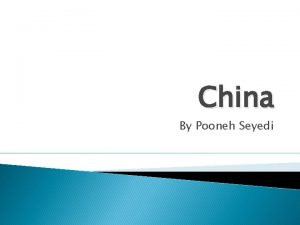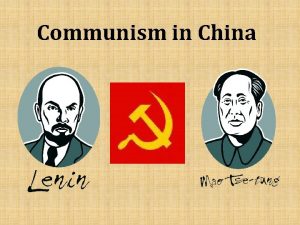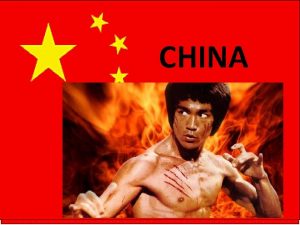Introduction on China History Of China China were

















- Slides: 17

Introduction on China


History Of China � � China were discovered in the Huang He basin and date from about 5000 B. C. It was following this initial flourishing of civilization, in a period known as the Chou dynasty (1122– 249 B. C. ), that Lao -tse, Confucius, Mo Ti, and Mencius laid the foundation of Chinese philosophical thought. In the T'ang dynasty (618– 907)—often called the golden age of Chinese history—painting, sculpture, and poetry flourished, and woodblock printing, which enabled the mass production of books, made its earliest known appearance. China is one of the world's oldest continuous civilizations

� The People's Republic of China (PRC), established in 1949, commonly known as China, has control over mainland China and the largely self-governing territories of Hong Kong (since 1997) and Macau (since 1999). � The Republic of China (ROC) established in 1912 in mainland China, now commonly known as Taiwan, has control over the islands of Taiwan, Penghu, Kinmen, Matsu, the Pratas island group, and a few other outlying islands.

Political power of China � � The politics of the People's Republic of China take place in a framework of a single-party socialist republic. The leadership of the Communist Party is stated in the Constitution of the People's Republic of China. State power within the People's Republic of China (PRC) is exercised through the Communist Party of China, the Central People's Government and their provincial and local counterparts. The more than 73 million-member[7] Communist Party of China (CPC) continues to dominate government. In periods of relative liberalisation, the influence of people and organisations outside the formal party structure has tended to increase, particularly in the economic realm. Under the command economy system, every state owned enterprise was required to have a party committee. The introduction of the market economy means that economic institutions now exist in which the party has limited or no power.

Economy of China � GDP (2009): $4. 814 trillion (exchange ratebased). Per capita GDP (2009): $3, 678 (exchange rate -based). GDP real growth rate (2009): 8. 7%.

Economy of China � Trade: Exports (2009)--$1. 194 trillion: electrical and other machinery, including data processing equipment, apparel, textiles, iron and steel, optical and medical equipment. Main partners (2008)-United States 17. 7%, Hong Kong 13. 3%, Japan 8. 1%, South Korea 5. 2%, Germany 4. 1%. Imports (2009)-$921. 5 billion: electrical and other machinery, oil and mineral fuels, optical and medical equipment, metal ores, plastics, organic chemicals. Main partners (2008)--Japan 13. 3%, South Korea 9. 9%, Taiwan 9. 2%, U. S. 7. 2%, Germany 4. 9%.

Language of China � 70% of them speak Mandarin � Mongolian, Tibetan, Uyghur and other Turkic languages (in Xinjiang), and Korean (in the northeast)

The Importance of China � The U. S. trade deficit and Chinese trade surplus created a surplus of dollars in China, which were invested in U. S. Treasuries and agency bonds, keeping interest rates low and indirectly financing the U. S. housing bubble and consumption binge of the last decade (and, therefore, growth in Chinese exports). � The general fear was that U. S. indebtedness would lead China to diversify away from U. S. assets, causing the dollar to fall and U. S. interest rates to rise, hurting the U. S. economy and making it harder to finance the national debt.

importance � The general fear was that U. S. indebtedness would lead China to diversify away from U. S. assets, causing the dollar to fall and U. S. interest rates to rise, hurting the U. S. economy and making it harder to finance the national debt. This may yet happen someday. But instead of demand for Treasuries collapsing, it’s been demand for every other type of asset that has fallen. Treasury yields have collapsed and the dollar has appreciated about 20%. Still, despite this increased purchasing power, the fall in U. S. (and global) consumption is having a severe impact on growth of the Chinese economy. Even though the Chinese government has signaled that it will do everything in its power to keep growth above 8% per year (down from 11 -12% in the past few years), the slowdown has severely constrained the ability of the urban manufacturing sector to absorb internal migration from the countryside, and there are signs of a reverse migration that is aggravating the problem of rural poverty in China. Although China may seem to have all the cards – high economic growth, large foreign currency reserves – it could yet turn out to be a major loser of the global economic crisis.

Why china is important � � � #1 in population (nearly 1. 3 billion people) #1 “middle class” urban consumers, estimated over 200 million #1 destination foreign investment (over $60 billion in 2004) #1 exporter to the US #4 world’s largest economy (will surpass Japan in next 5 years, the US in next 15) #1 consumer of steel and oil, soon to be the largest manufacturer in the world

FDI inflows into China 1984 -2009 � � Hurt by the global financial crisis since last October, FDI into China began to decrease from a year earlier, and fell 2. 02, 36. 52 and 5. 73 percent respectively during the last three months of 2008. But this did not pull back the growth momentum for the whole year. According to the Ministry of Commerce, China absorbed FDI worth $111. 17 billion in 2008, up 27. 65 percent year-on-year. In comparison, the global FDI dropped by 21 percent year-on -year to $1. 45 trillion, largely due to the 32. 7 percent slump in FDI with developed nations, according to statistics from the United Nations. From January to April, the FDI into China fell by 32. 6, 15. 8, 9. 5 and 22. 5 percent respectively year-on-year.

SWOT Analysis Strengths � � � Strength of China Attractive Destination for Expatriates Changes Due to the 2008 Olympics Cheap Cost of Labor Educated Workforce and Scale Government Support Holistic Thinking Domestic Market Attraction and Growth Large Overseas Chinese Population Japanese and Korean Language Skills Political Stability and Security Quality and Cost of Infrastructure

Weakness � � � � � � Constantly Being Compared With Indian and Western Companies English Language and Communications Skills A Culture of Not Challenging Authority Highly Visible Conflict Between Regions and Cities Country Not Fully Prepared for BPO Critical Shortage of Skilled Resources ITO and BPO Companies Are Very Small Lack of BPO Awareness and Misconception of What's Possible Lack of Awareness of Japan/South Korea Opportunities Lack of International Name Brands Lack of One-Stop Destination for Information Lack of Process Maturity Limited Global Exposure and Experience Misinformation in Overseas Markets About China Low Awareness of China as an ITO or BPO Destination Poor Intellectual Property Record — Lack of Trust Poor Marketing and Selling Skills Shortage of Mid-Top-End Skilled Professionals and Management Taxation for Foreigners and Cost of Living Extreme Tensions Between China and Japan Virtually Nonexistent BPO Industry Weak R&D Budgets and Efforts Bigger Companies Are Failing to Lead the Way

Opportunities � � � � � Business Continuity Planning Cooperation With India E-Government and E-Education Initiatives Entering an Established Market Vertical Industry Expertise (Manufacturing/Supply Chain) Japanese and South Korean Markets Leveraging Multinational Presence in China Nonresident and Overseas-Trained Chinese Talent Pool Streamlining Processes Within Government for Software/Service Exports

Threats Comparisons to India Currency Devaluation/Inflation Different Expectations Between Domestic Market and International Markets Distrust of Legal System and Lack of Transparency Immaturity of Japanese and South Korean Outsourcing Markets Lack of Focus MNCs and Indian Companies Are Taking Key Employees and a Majority of the Work Offshore Backlash Slower Development of Business Relationships

Conclusions and Recommendations � Business Process Outsourcing � IT Outsourcing �
 Was were going to future in the past
Was were going to future in the past Why did many aristocrats favor the philosophy of legalism?
Why did many aristocrats favor the philosophy of legalism? Collectivization ap world history
Collectivization ap world history Chinese dynasties
Chinese dynasties Global history imperialism in china
Global history imperialism in china And then there were none introduction
And then there were none introduction Also history physical
Also history physical History discipline in social science
History discipline in social science Introduction to history of education
Introduction to history of education Salvation history module
Salvation history module Essay structure introduction
Essay structure introduction You were the word in the beginning
You were the word in the beginning Apushreview.com
Apushreview.com She was known for her beauty and generous
She was known for her beauty and generous Causes of imperialism
Causes of imperialism Destilbe
Destilbe Where were the sumerians
Where were the sumerians Patolli
Patolli




